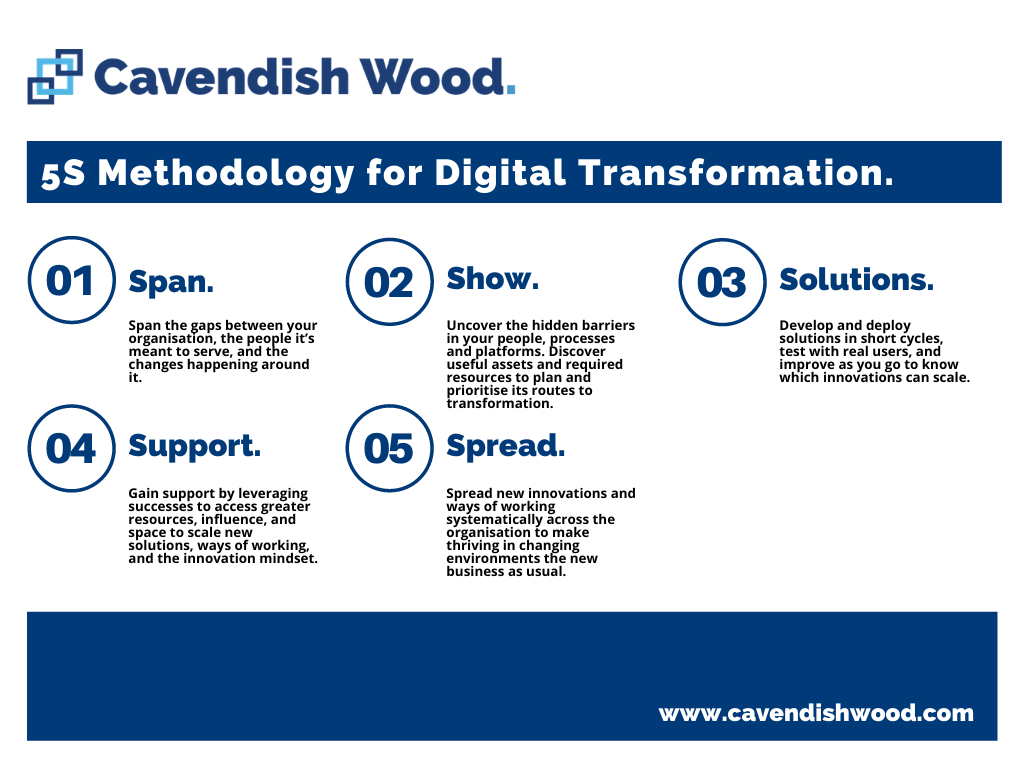
In my previous articles on digital transformation for the UK's private sector, I outlined the three pivotal objectives businesses must focus on to drive their digital initiatives. I also touched upon the common challenges and roadblocks that often make digital transformation seem like a daunting task for many organisations.
I introduced the "5S Methodology for Digital Transformation," a framework honed over the last five years through collaboration with both public and private sector organisations to achieve impactful and enduring transformation.

In this third instalment of the series "Private Sector Digital Transformation – A Blueprint for Success," I'll delve into the third phase of the 5S methodology: "Solutions."
In the first phase, "Span," you established valuable connections from within your organisation to the external world. You engaged in meaningful conversations with customers, industry peers, and partners to gather actionable insights and data. This enabled you to understand what precisely needs to change and how urgently.
Based on this intelligence, you formulated a "Shared Vision for Transformation," a clear set of statements that depict your organisation's current state, its future aspirations, and the reasons for change.
You also assembled a leadership team tasked with steering the transformation journey, ensuring that resources and budgets are allocated to embark on your digital voyage.
In the second phase, "Show," you identified and addressed all the hidden barriers to transformation within your organisation. You also discovered essential assets and resources, laying the groundwork for the initial projects to help you realise your digital transformation vision.
For CEOs, Senior Business Leaders, CIOs and CTOs in the UK's private sector, this phase is crucial. It's where the rubber meets the road, and your well-laid plans begin to take shape in the form of actionable solutions. Stay tuned as we explore how to make this happen.
Solutions.
This phase is the crucible of transformation, where your well-laid plans and strategies begin to materialise into actionable solutions. It's where you tackle the prioritised business challenges and opportunities identified in the earlier phases. However, the approach to achieving success in this phase can be a stumbling block for many private sector organisations, not just local authorities.
Before diving into the 'how,' let's discuss the 'how not to.' Digital transformation is inherently stressful. You're venturing into largely uncharted territory, with unknown hurdles, costs, and often, a fair amount of internal resistance and scepticism. This heightened pressure can lead to counterproductive outcomes.
Under such scrutiny, leaders often revert to traditional management techniques—detailed project plans, risk logs, budgetary structures, and so on. These methods are not conducive to digital transformation. Given that the solutions are still unknown, any planning is speculative at best and is likely to fail. This pressure is often exacerbated by finance departments, who may mistakenly consider themselves outside the scope of digital transformation. Trying to shoehorn digital initiatives into rigid 1, 3, or 5-year budget plans is a surefire recipe for failure.
An iterative approach to digital transformation.
So, what's the right way to tackle this crucial phase? In a word: iteratively. Iterative development is the cornerstone of successful digital transformation. It minimises waste, delivers value early, and ensures solutions are fit for purpose. Real user feedback after each iteration allows for quick course corrections, saving time, resources, and budget.
You don't need to adopt a full-fledged Agile lifecycle; not every role and ceremony in Agile is mandatory. While Agile principles are beneficial, a purist Agile approach may not be practical for all private sector environments. Instead, I often recommend a hybrid approach, incorporating elements from Agile, Design Thinking, and LEAN methodologies. These frameworks emphasise continuous improvement, user-centric design, and prototyping—key components for developing solutions in today's digital landscape.
However, some groundwork is needed before you embark on this iterative journey. Given that this approach is a departure from traditional methods for many organisations, you'll need to implement new processes, governance structures, and organisational changes to ensure rapid and effective solution delivery.
This phase is not just a procedural shift but a cultural one. It sets the stage for a more agile, responsive, and innovative organisation, better equipped to navigate the complexities of the digital age.

Innovation framework.
If you've followed my previous discussions on the initial phases of the "5S Framework for Digital Transformation," you'll understand that digital transformation must be led by the business, not just the IT or digital programme team. The insights into processes, customer pain points, efficiency opportunities, new revenue streams, and the myriad benefits digitalisation can offer reside within the business units. These stakeholders need a streamlined, transparent process to ensure their ideas for digital change are continually surfaced, evaluated, and, if beneficial, moved into the implementation pipeline.
There are multiple ways to achieve this. For instance, developing a collaborative tool using PowerApps can be an excellent method to engage everyone in the organisation. It offers a straightforward and transparent way to propose digital initiatives, track decision-making, and monitor the value delivered through various projects. Alternatively, a simple SharePoint list accessible to the entire organisation can suffice. The key is to have a mandated, structured process for capturing these insights and funnelling them into the digital transformation programme.
Project evaluation & approval process.
Once you have a mechanism to surface innovative ideas from various business units, the next step is to evaluate and either approve or reject each proposal. This is a straightforward yet crucial process for the overall success of your digital transformation efforts.
Upon receiving each idea, deploy a business analyst to validate and elaborate on the projected benefits. Potential solutions can be discussed and evaluated if the benefits hold up under scrutiny. This should be done centrally to leverage existing solutions that may already be in place within other parts of the organisation.
For example, if one department needs a tool for reviewing and approving service requests, it might be possible to adapt an existing tool or application, rather than building something new or purchasing an off-the-shelf solution. This approach saves time and money and should always be the first option considered.
Once a potential solution is identified and there's agreement on its suitability, clarity on costs, and expected benefits, the project can be approved. Budgets can be allocated, and the project can join the queue for implementation.
This phase is about project management and fostering a culture of innovation and continuous improvement. It's about ensuring that your digital transformation efforts align with real business needs and opportunities, thereby ensuring a higher likelihood of success and ROI.
Benefits management framework.
Once your organisation is actively generating ideas for digital transformation, and you've evaluated their potential benefits in line with your transformation goals, establishing a robust Benefits Management Framework is the next crucial step. This framework serves as the mechanism for tracking and reporting the real-world benefits of each digital initiative.
The importance of this framework cannot be overstated. Without it, you risk having a series of isolated, innovative projects that deliver value but go largely unnoticed because there's no centralised reporting of their benefits. This can create a skewed perception among senior leadership, who may only see the upfront costs of large-scale initiatives, like migrating to Microsoft 365, without recognising the longer-term benefits.
For instance, consider a migration to Microsoft 365. On its own, it doesn't change much. However, the benefits are substantial if a legal department leverages Power Apps or SharePoint Workflow to automate document reviews and case management. Such a move could save countless hours of manual work, retire outdated legacy systems, and eliminate associated support and license costs. Yet, these benefits often go unreported, overshadowed by the initial costs of the migration.
Addressing the Cost Fixation in Digital Transformation.
This scenario could be playing out across various departments in your organisation. Imagine the cumulative impact of such unreported benefits, especially when juxtaposed against the initial costs of platform adoption. Therefore, capturing every benefit—from financial savings to efficiency gains—is not just good practice; it's the essence of digital transformation.
Another vital component of your Benefits Management Framework is its dynamic nature. It should be updated regularly as projects are completed, replacing forecasted benefits with actual outcomes. Failing to do this will result in inaccurate data, which serves no one. If you find that the actual benefits consistently fall short of forecasts, this discrepancy can be analysed to identify and address the root causes. Remember, digital transformation aims to effect genuine, measurable change within the business. Inflating forecasts serves no purpose and can even undermine the momentum of your digital transformation programme.

This framework is not just a tracking tool but a strategic asset. It provides the data required to make informed decisions, allocate resources wisely, and, most importantly, demonstrate the ROI of your digital transformation efforts to stakeholders at all levels.
Prioritised project list.
Creating a prioritised project list is a pivotal step in your digital transformation journey, and it should be approached with a clear understanding of your organisation's overarching goals and existing barriers. This list is the culmination of the insights and priorities you've gathered in the previous phases of your transformation strategy.
Your organisation may have multiple transformation goals, each with its own level of urgency and importance in your broader strategic vision. Likewise, the "Paths to Transformation" you identified in the earlier phase will have varying degrees of priority. These strategic priorities should be weighed alongside tactical considerations such as budget constraints, quick wins, and ROI to assign a priority level to each project.
Importance of clear communication.
It's crucial that everyone within the organisation understands these priorities. Some departments may feel overlooked or left behind, so maintaining open lines of communication is essential. Explaining why certain projects take precedence over others can help keep all business areas engaged in the transformation process, preventing them from becoming disenchanted or disengaged.
The nature of the prioritised list.
It's important to clarify what this prioritised list is not. It is not a project or programme plan, nor is it tied to resource or budget planning or dependencies. It should remain a dynamic list, open to adjustments as new insights are gained, and priorities shift. If this list morphs into a rigid plan, it's almost certain to fail.
This prioritised project list is a strategic guide, not a binding roadmap. It offers a structured way to approach transformation projects, allowing for flexibility and adaptability—key attributes for any successful digital transformation initiative.
Solution development lifecycle.
In the private sector, the approach to solution development needs to be agile, iterative, and aligned with the business objectives. Traditional methods of project management often fail to deliver in the fast-paced digital landscape.
Here's how you can approach solution development in a way that fosters innovation and ensures alignment with your digital transformation goals:
The need for an iterative approach.
Innovation thrives in an environment that allows rapid experimentation, prototyping, and early user feedback. Unlike traditional IT projects focusing solely on the end product, an iterative approach allows you to adapt and refine the solution based on real-world feedback. This is essential for fostering a culture of innovation and is a cornerstone of any successful digital transformation.
The shift in mindset.
The shift from a product-centric to a process-centric approach is more than just procedural; it's a change in mindset. In the digital age, failure is not a setback but a stepping stone towards innovation. It provides valuable insights that can guide the project's direction. This is a stark contrast to traditional methods where failure is often costly and to be avoided at all costs.
Simplifying the process.
While Agile methodology is a popular choice for iterative development, it's not a one-size-fits-all solution. Agile comes with its own set of terminologies and ceremonies that may not be necessary or even beneficial for every organisation. Instead, consider adopting a simplified, customised approach that aligns with your organisation's specific needs.
Incorporating other methodologies.
In addition to Agile, methodologies like Design Thinking and Lean can offer valuable perspectives. These approaches focus on customer-centric design, continuous improvement, and efficient use of resources, which can be incredibly beneficial in shaping your solution development process.
Key takeaways.
- Iterative development: Plan, design, build, and test in cycles, allowing for adjustments based on real-world feedback.
- Customisation over pure agile: Adopt the principles that make sense for your organisation, rather than sticking rigidly to a methodology.
- Cross-functional collaboration: Involve various departments to ensure the solution meets diverse business needs.
- User feedback: After every iteration, gather user feedback to ensure the solution is aligned with real-world needs.
By adopting an iterative approach to solution development, you not only increase the likelihood of project success but also lay the foundation for a culture of innovation and continuous improvement within your organisation.
Empowered cross-functional teams for initial projects.
In the UK's private sector, the concept of empowered cross-functional teams is not just a nice to have but a necessity for driving digital transformation. These teams bring together diverse skill sets and perspectives to tackle complex business challenges, and their effectiveness is often the difference between a successful transformation and a failed one.
The essence of an effective cross-functional team.
While the basic idea of a cross-functional team is straightforward—a group of individuals from different departments working together—its success hinges on several key factors:
Collaboration.
Effective collaboration is the bedrock of a successful cross-functional team. This goes beyond weekly meetings or email threads. Teams should have the tools and platforms that allow for real-time collaboration on documents, designs, test results, and other project components. Microsoft Teams is an excellent tool, but other options like Slack, Asana, or Jira can facilitate seamless collaboration.
Autonomy.
Micromanagement is the enemy of innovation. For a cross-functional team to truly thrive, it needs a certain level of autonomy. While the team's work may be part of a broader programme, it should be free to govern itself to some extent. This autonomy allows the team to adapt and pivot as they learn, which is crucial for finding the most effective solutions.
Empowerment.
Empowerment goes hand-in-hand with autonomy. Teams should be empowered to experiment—and even to fail. Failure is not a setback but a learning opportunity that can lead to more effective solutions. An empowered team is likelier to take calculated risks, think outside the box, and develop innovative solutions.

Why this matters for the private sector.
In the competitive landscape of the private sector, the ability to innovate rapidly is often a key differentiator. Empowered, autonomous, and collaborative cross-functional teams are well-suited to meet this need. They can quickly adapt to market changes, respond to customer needs, and drive the organisation's digital transformation goals forward.
By focusing on these key aspects of collaboration, autonomy, and empowerment, you set the stage for a more agile, responsive, and effective organisation. This is not just a pathway to successful digital transformation; it's a blueprint for long-term business success.
Starting small.
For CEOs, Senior Business Leaders, CIOs and CTOs in the UK's private sector, the temptation to go big right from the start can be overwhelming. However, launching a multi-million-pound project to overhaul every customer-facing system isn't the wisest first step. Such projects are not only expensive but also fraught with risk and complexity.
Focus on quick wins.
Instead, consider starting with smaller, more manageable projects that offer quick wins. These could be initiatives that automate manual processes, improve data flow between customer service and other departments, or enhance existing systems with minimal investment. The key is to focus on projects that can show immediate benefits, both in terms of cost savings and improved customer experience.
Leverage existing tools.
Many organisations already have a suite of tools at their disposal that can be used to make significant improvements. For instance, if your company is already using Microsoft 365, you have access to a range of features that can automate workflows or even allow you to develop small applications using Power Apps. A little training can empower your teams to start making these changes themselves, thereby reducing the need for external expertise and additional costs.
Track and measure.
It's crucial to track the benefits each initiative delivers. This data helps refine your approach and demonstrates the value of digital transformation to senior leadership. In a private sector environment where ROI is king, showing tangible benefits is invaluable for gaining further support and budget for future projects.
Why this matters.
Starting small allows you to show quick, tangible benefits that can win over sceptics within the organisation. It also enables you to iron out any kinks in your approach to digital transformation, making it easier to tackle more complex projects later on. This is particularly important for gaining the support—and budget—you'll need to scale your efforts.
In the next part of this series, we'll delve into the "Support" phase of the 5S transformation framework, focusing on how to win more backing for your digital transformation initiatives. But remember, the success of any large-scale transformation effort is often predicated on the smaller wins you accumulate along the way. Click here to read "Support" now.

